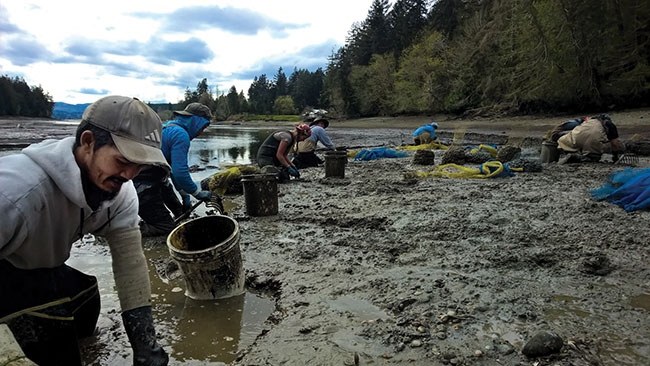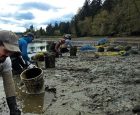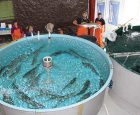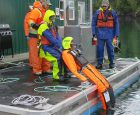
HR ups its game as aquaculture competes for talent
May 14, 2019
By Lynn Fantom
Jamie Rouleau, who sports a long, blonde braid and pals around with a nine-year-old Husky-Shepherd, was born in Campbell River, British Columbia and grew up nearby, hunting and fishing with her brother and dad. After high school, she worked at a fish processing plant and, as a technician, at a freshwater salmon nursery. Then the site closed.
 Taylor Shellfish farmers harvest clams. It is a job that requires stamina but offers the beautiful surroundings of the Pacific Northwest
Taylor Shellfish farmers harvest clams. It is a job that requires stamina but offers the beautiful surroundings of the Pacific Northwest But with the same company, Jamie was able to transfer to sea sites and was promoted to assistant manager. Curious about First Nations culture, she ventured to the remote BC community of Klemtu and spent the next four years working eight-day shifts and commuting home to Courtenay for six. She was the first woman in a management role on Mowi sea sites.
Today, she has taken on a new challenge: managing marine logistics with specialized software. She works in an office now, but still spends her free time outdoors.
Jamie’s story, drawn from Mowi Canada West’s Wharfside newsletter, tells how tough—physically and socially—it can be to climb aquaculture’s corporate ladder. But it also suggests the benefits: a career track with many options, opportunities to learn, and the joy of working outdoors. For aquaculture companies grappling with recruiting, hers is also a lesson in how to get and keep the right people.
Jamie was lucky to grow up near Campbell River, a hub for aquaculture. Many in her generation from other parts of Canada and the US have less awareness of the opportunities in fish farming. Marianne Naess, director of operations, North America, Nordic Aquafarms, says, “It’s the industry of the future.” In fact, farmed fish production must more than double in the next 30 years to meet the needs of a protein-hungry world.
Not only is aquaculture a growing, changing business, says Dean Dobrinsky, human resources director for Mowi, it also offers many career paths. Mowi’s 600 people can work in sea site farming, hatchery production, marine operations, fish processing, and business—or move among them, as Jamie Rouleau did. And those roles can take global routes. For example, Cermaq offers work exchange programs in Norway, Chile, and Australia, according to Shannan Brown, people and culture director.
Still, recruiting talent can be challenging, leaving over 10 percent of jobs unfilled, experts told Aquaculture North America (ANA). It’s a business that’s battling low unemployment rates, an aging demographic, and job appeal dampened by remote locations and hard physical work.
“It takes stamina and grit to stick with these jobs,” says Bill Dewey, director of public affairs at Taylor Shellfish Farms, which employs some 630 people growing oysters, clams, mussels, and geoducks in Puget Sound, Washington. It is Taylor’s mission to bring shellfish “from tide to table.” But in the winter, when the tides are lowest at night, that means harvesters wear headlamps to do their jobs.
“It’s a way of life,” says Russ Walker, Taylor’s safety/HR manager. “Working with Mother Nature, the tides, and the weather, it’s constantly changing schedules and night-time work.”
And employees at the sea sites of BC salmon farms have their own scheduling challenges: they live on a floating barge for eight days followed by six days off.
Recruiting: A never-ending cycle
Staffing businesses like these especially in a tight labor market is an ongoing effort and requires creativity and the adoption of new tools.
For near-term needs, Taylor Shellfish hosts open hiring events. But conscious of the long-term, the HR team participates in job fairs at colleges throughout the Pacific Northwest, as well as high school career fairs. “It gets our name out there,” says Walker. “We’re investing in the future. It’s a never-ending cycle.”
Dobrinsky of Mowi agrees that a good way to source candidates is by building relationships with universities, which Mowi visits sometimes twice a year. The recruiters give “very realistic” profiles of the jobs and answer a lot of questions, he adds.
When Cermaq does its recruiting at career fairs and community events, these days HR is bringing something new, a six-minute movie created in Virtual Reality—plus viewing goggles. “The 360-degree experience is a great way to show the fish farming experience,” says Brown.
Brown also invests time into her own LinkedIn page, which she says is “valuable for recruitment.” She may post an inspirational message from Bill Gates, a personal photo from Team Spirit Day showing herself in a sports jersey, or job openings at other companies in Campbell River—or Cermaq, of course. “It is a great way to convey the company’s culture and open a private channel of communication with potential recruits,” she says.
Internships also play a role in a comprehensive recruiting program. Taylor offers a three- to four-month paid internship that teaches people all aspects of working on clam, oyster, and geoduck farms, from planting to maintenance to harvest. Interns work side by side with farm managers. It has proven to produce a good middle-management talent pool, notes Dewey.
Mowi also hires summer interns from which they can pluck viable candidates for long-term development.
Since so much of the workforce is drawn from local communities, the image of these companies is fundamental. And a lot of good work stems from that.
For example, Mowi offers its communities a Salmon Barbeque Event Trailer for local fundraising initiatives. The company provides the trailer, chef, utensils, and all ingredients for a salmon burger or miso salmon salad—even gluten-free options. A local group, whether a sports team or charity, benefits from the proceeds from the food cart sales.
In their daily lives, employees play a role in the community too. “We are the hockey and soccer coaches, the gymnastics people,” says Dobrinsky.
“Public outreach is huge for us,” Taylor’s Walker agrees. The farm produces educational videos on how to plant shellfish and publishes informational posts like “What in the ‘sea’ is a geoduck?” It also participates in Pacific Coast Shellfish Growers Association’s Washington Shellfish Week, offering shucking lessons, farm tours, and cooking events.
HR tech toolkit expands
To onboard employees, farmers like Taylor are taking advantage of online HR systems, although safety training is always conducted in person, Walker emphasizes. Cermaq is moving to an online system that manages everything from goal-setting to paid time off, and Brown points to the convenience that mobile access offers employees.
Mowi has developed a Technician Advancement Program with four levels of education, training, and mentoring that moves employees to a management tier. Participants are evaluated at each level and are also paid more as they advance. An e-learning component is self-driven. “We have to grow our people from within,” Dobrinsky says. But this program is now the model for aquaculture certification at a local college.
In February, Cermaq began new Technicians’ Academies, which are week-long training programs that will be conducted twice a year. Brown, fresh from a management conference herself, says that Cermaq has combined subjects that have been taught in single-day sessions. Employees learn about technology, equipment, safety, and fish health (they even did a dissection), while experiencing the opportunity to come together as “one company.”
Brown says, “We will always have peer-to-peer and peer-to-manager learning, but we are incorporating more formal knowledge transfer and enhancement. We are just beginning this journey.”
Even as companies are formalizing their training, they emphasize the need to be responsive to circumstances. When Mowi saw an uptick in incidents that had the potential for serious injury, they brought in managers for a one-day “safety training reboot.” Similarly, over the years Taylor has responded to dramatic growth spurts by tapping external training and development resources for classes on communications, moderating disputes, and digital skills.
If employees don’t grow, they go
“The workforce today needs more touch points,” says Mowi’s Dobrinsky. Employees are looking for training but also the coaching to help them understand where it will take them. Introducing more regularly scheduled career counseling is on Dobrinsky’s docket for this year.
At Grieg Seafood, HR Manager Alina Constantin meets with every new employee after 30 days with the company. Since 2017, she has been refining all employee job descriptions, as well as the performance appraisal system. “This makes it clear what employees have to achieve before they can get to the next level,” she says. “If they can’t see where they can grow, they go somewhere else.”
The job descriptions include both technical and behavioral competencies. A technician, for example, must be able to lift at least 50 lbs. But all employees at Grieg must build behavioral skills appropriate for their positions. Developed with organizational consultant Korn Ferry, these include how well a person makes decisions, demonstrates accountability, deals with change, and is engaged and eager to grow.
Grieg measures that employee engagement company-wide by sending its 150 employees a Gallup survey that asks 12 questions such as “Is there someone at work who encourages your development?” and “Does the mission of the company make you feel your job is important?”
From results, the leadership team can develop relevant programs to improve engagement. This Gallup employee engagement research has been conducted with more than 35 million employees and, among other findings, shows that companies in the top quartile of engagement scores have 70 percent fewer safety incidents than those at the bottom.
Clearly, aquaculture companies are addressing their workforce needs with ingenuity and investment. Part of the solution has been increased automation.
Taylor, for example, has perfected a clam harvesting machine based on one originally designed to dig tulip bulbs. And they have sourced innovative equipment from all over the world, such as Italy and France.
Technology has also been reshaping salmon farming. “It wasn’t so long ago that fish were fed from a bucket,” says Dobrinsky. Today there are state of the art, computer-driven systems with real-time monitoring to feed the fish but also provide aeration, light, and waste management.
Even as technology advances, finding the right people will remain a priority, Dobrinsky says. What are companies looking for? Passion is the quality that resounds in aquaculture career talk—passion about the product, co-workers, the community, and the environment.
Brown clinches it: “We are looking for people who want to be part of a solution: we produce food.”










